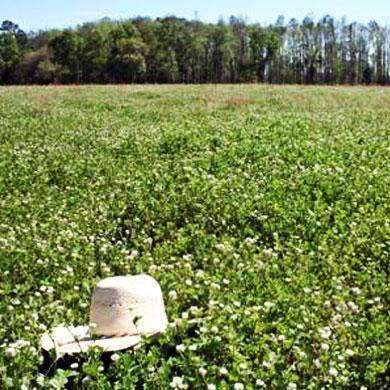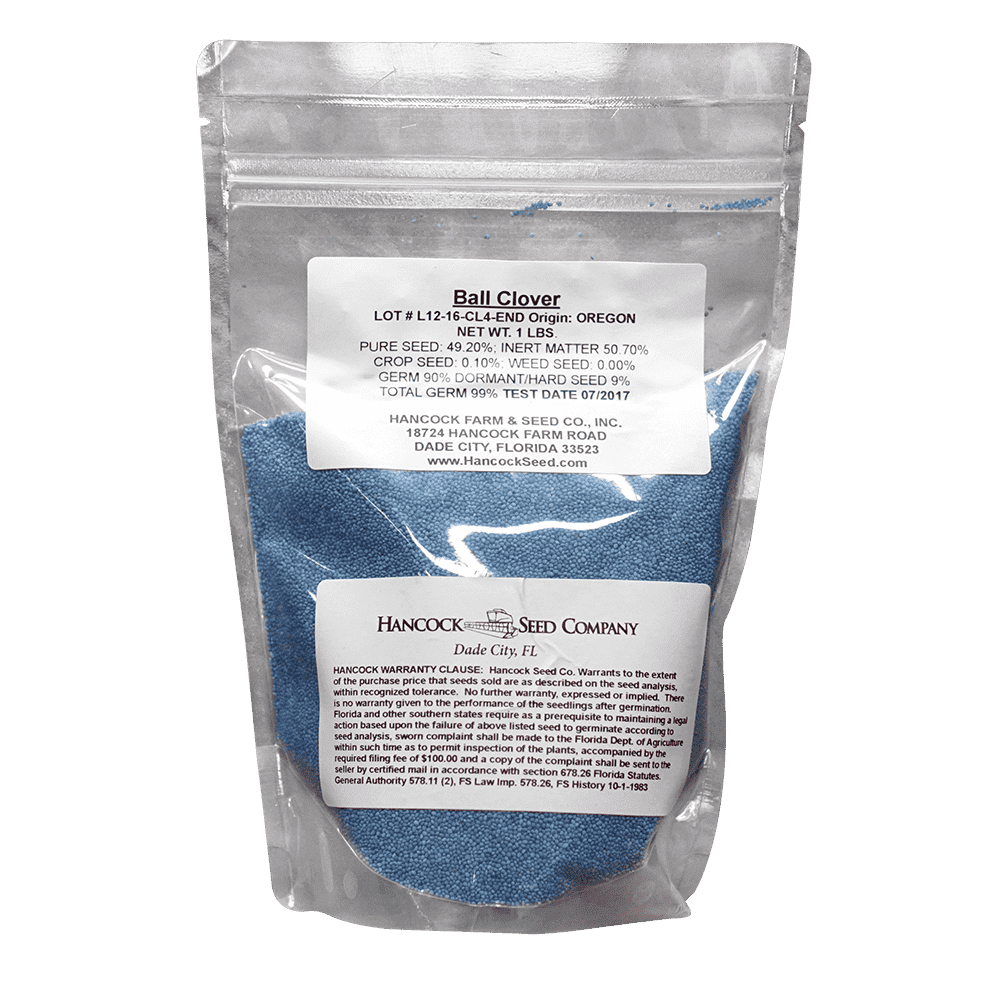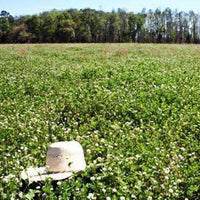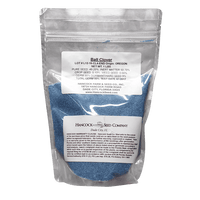
- When to plant:
- Spring, Fall, Winter
- Fertilizer:
- Varies
- Seeding rate:
- 3 - 4 lbs. per acre
- Overseeding rate:
- 2 lbs. per acre
- Seeding depth:
- 1/4 inch
- Ideal ph:
- 6.5
- Gmo:
- No
- Inoculant needed:
- No
- Coated or raw:
- Coated
- Lifecycle:
- Annual
- Climate zones:
- Cool Season, Transition Zone, Warm Season
Ball Clover is one of the best options for those looking for an excellent reseeding clover. It is a prolific seed producer even under high stocking rates, and a high percentage of the seed are hard seed.
Product Information
- Application or Use: Cattle Forage, Livestock Grazing, Food Plot, Cover Crop, Erosion Control
- Germination Time: 5 - 7 days, under optimal conditions
- Growing Locations: Warm Season, Transition Zone, Cool Season
- Height: 1 - 2 feet
- Sunlight Requirements: 4+ hours
- Advantages: Prolific seed producer even under high stocking rates, and a high percentage of the seed are hard seed.
- When to Plant: Recommended planting time is fall and spring when night time temperatures are consistently below 65 degrees.
Product Details
- Excellent reseeding clover
- Primary growth in mid-spring
- Well adapted to dry sites
- Great for wildlife food plots
-
Commonly used for Honey Bees
Product Information
Growth Habit: Short, 1-2 feet tall, erect growth, low growing, looks like white clover.
Origin: Mediterranean Region
Production Season: March to June. Late maturing, late production, similar to Arrowleaf clover.
Nutritive Value: Varies depending on maturity (leaf:stem ratio). Usually medium to high crude protein; medium to high digestibility.
*Product packaging may appear different than what is pictured.
Plant in the Fall at a rate of 3-4 lbs per acre. This seed needs to be at a rate of 1/4 and prefers a pH of 6.5.
When choosing to start a new lawn, remove old vegetation by using a de-thatcher, power rake or tiller to kill the existing vegetation. Rake or drag the area to remove debris and dead grass for a clean area. Ensure the soil is leveled and loosened to allow the seed to have good soil contact once spread on a clean seed bed.
If you have an area with heavy weed coverage, we recommend starting fresh by killing and removing the existing vegetation. If you choose to use chemicals, herbicides or fertilizers, you must check with the product's manufacturer prior to planting new seed to ensure the proper waiting period.
When overseeding an existing area, mow your lawn at the lowest setting and bag the clippingsx. Rake or drag any areas that have dead thatch or debris.

Seed Quality
Hancock Seed is dedicated to delivering the best seeds possible to our customers. Hancock Seed grows and harvests many of our products, and we acquire the majority of the rest from other family farmers.
All these seeds are processed, packaged and shipped from Hancock Farm. This helps us ensure that our high standards are met. Unlike much of the competition, we refuse to sell you a seed that was not gathered during the last harvest. You will always receive fresh product from Hancock.
Every seed we grow comes with 40 years of experience behind it...you can rest assured that all of our products are cultivated in a method that assures its potential for growth.

Your cart ( 0 )

Ball Clover is one of the best options for those looking for an excellent reseeding clover. It is a prolific seed producer even under high stocking rates, and a high percentage of the seed are hard seed.
Product Information
- Application or Use: Cattle Forage, Livestock Grazing, Food Plot, Cover Crop, Erosion Control
- Germination Time: 5 - 7 days, under optimal conditions
- Growing Locations: Warm Season, Transition Zone, Cool Season
- Height: 1 - 2 feet
- Sunlight Requirements: 4+ hours
- Advantages: Prolific seed producer even under high stocking rates, and a high percentage of the seed are hard seed.
- When to Plant: Recommended planting time is fall and spring when night time temperatures are consistently below 65 degrees.
Product Details
- Excellent reseeding clover
- Primary growth in mid-spring
- Well adapted to dry sites
- Great for wildlife food plots
-
Commonly used for Honey Bees
Product Information
Growth Habit: Short, 1-2 feet tall, erect growth, low growing, looks like white clover.
Origin: Mediterranean Region
Production Season: March to June. Late maturing, late production, similar to Arrowleaf clover.
Nutritive Value: Varies depending on maturity (leaf:stem ratio). Usually medium to high crude protein; medium to high digestibility.
*Product packaging may appear different than what is pictured.
Plant in the Fall at a rate of 3-4 lbs per acre. This seed needs to be at a rate of 1/4 and prefers a pH of 6.5.
Instructions
When choosing to start a new lawn, remove old vegetation by using a de-thatcher, power rake or tiller to kill the existing vegetation. Rake or drag the area to remove debris and dead grass for a clean area. Ensure the soil is leveled and loosened to allow the seed to have good soil contact once spread on a clean seed bed.
If you have an area with heavy weed coverage, we recommend starting fresh by killing and removing the existing vegetation. If you choose to use chemicals, herbicides or fertilizers, you must check with the product's manufacturer prior to planting new seed to ensure the proper waiting period.
When overseeding an existing area, mow your lawn at the lowest setting and bag the clippingsx. Rake or drag any areas that have dead thatch or debris.


















